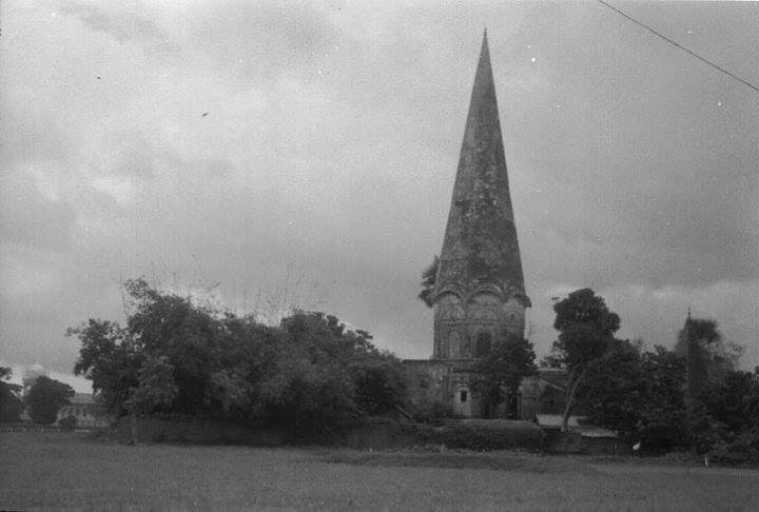On Friday (December 17), President Ram Nath Kovind inaugurated the reconstructed Ramna Kali temple in Ramna, a part of the Bangladeshi capital Dhaka where the landmark Suhrawardy Udyan (the former Ramna Race Course) is located.
The temple was destroyed by Pakistani forces during their Operation Searchlight in March 1971, the brutal crackdown that led to the genocide and the Bangladesh War of Liberation.

“The historic Ramna Kali temple is a symbol of the spiritual and cultural bonding among the people of India and Bangladesh,” Kovind said on Friday.
After Bangladesh threw off Pakistan’s yoke, a small temple was set up at the site for people to offer prayers. A reconstruction of the complex was announced in 2017, when then External Affairs Minister, the late Sushma Swaraj, inaugurated 15 development projects in Baridhara, Dhaka.
The Ramna Kali Temple
In the 17th century, Dhaka was a provincial capital of the Mughal Empire, and an important trading centre. The history of the area called Ramna (‘lawn’ in Persian) can be traced back to the early 1600s, when it was occupied by high officials of the Mughals. There was a Mughal garden, open green spaces, and garden houses. After Dhaka passed under British rule in 1858, the “jungle of Ramna” was cleared, and a race course and boulevard were built for the pleasure of the Raj elite.
The temple in the area, dedicated to the Goddess Kali, is believed to have been built during the Mughal period. Professor Muntassir Mamoon, one of the most eminent historians of Bangladesh, told The Indian Express that the temple was around 400 years old, even though it is difficult to pinpoint a year in which it was built.
“The temple was built by a Hindu sect, but it is difficult to identify exactly who built it. It is said that it was built by a certain Haricharan Giri who was a mahant in the temple, but we cannot be sure. It was not a very large temple, and was fairly ordinary in terms of its architecture. However, it is the second oldest Hindu temple in Bangladesh, the Dhakeshwari Temple being the oldest,” Prof Mamoon said.
Story continues below this ad
The temple gained prominence in the early 20th century when the renowned saint Ma Anandamayi built her ashram in its precincts. Anandamayi was popularly addressed as “Shahbag-er ma”, or the Mother of Shahbag, Prof Mamoon said.
 The temple was destroyed by Pakistani forces during their Operation Searchlight in March 1971, the brutal crackdown that led to the genocide and the Bangladesh War of Liberation.
The temple was destroyed by Pakistani forces during their Operation Searchlight in March 1971, the brutal crackdown that led to the genocide and the Bangladesh War of Liberation.
The Temple and the War
On March 27, 1971, the Pakistani army destroyed the temple and massacred 85 Hindus, including priests and devotees, according to ‘Minorities and the State: Changing Social and Political Landscape of Bengal’, an edited volume published in 2011.
Prof Mamoon said the temple was close to the Dhaka University campus, and the Pakistanis attacked the campus before turning on the temple. “It was prominent since it was in the vicinity of the university. The other temples are in the old city,” he said. “The temple was small but it had a tall spire. So it was visible from far away as a Hindu temple.”
Story continues below this ad
Days before the temple was razed, Bangabandhu Sheikh Mujibur Rahman delivered his historic March 7, 1971 speech at the Ramna Race Course maidan, in which he exhorted Bengalis: “The struggle this time is for emancipation! The struggle this time is for independence!”
In one of the photographs from that day (available on the Bangabandhu Museum website), the Bangabandhu can be seen amid a sea of people, with the pyramid-shaped peak of the Ramna Temple in the background. This is believed to be one of the last pictures of the temple available in the public domain.
On January 10, 1972, with Pakistan defeated and Bangladesh liberated by the Indian Army, the triumphant Bangabandhu returned to the maidan. “My countrymen, rejoice. Bangladesh is now a sovereign, independent nation,” he said. This time, there was no temple as the backdrop, however.
Newsletter | Click to get the day’s best explainers in your inbox



 The temple was destroyed by Pakistani forces during their Operation Searchlight in March 1971, the brutal crackdown that led to the genocide and the Bangladesh War of Liberation.
The temple was destroyed by Pakistani forces during their Operation Searchlight in March 1971, the brutal crackdown that led to the genocide and the Bangladesh War of Liberation.




































